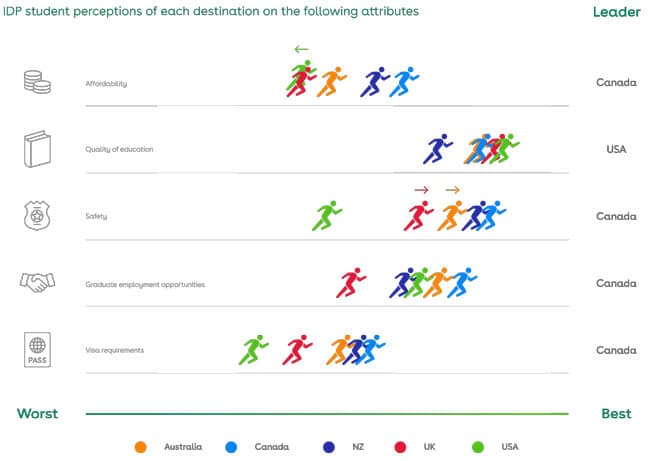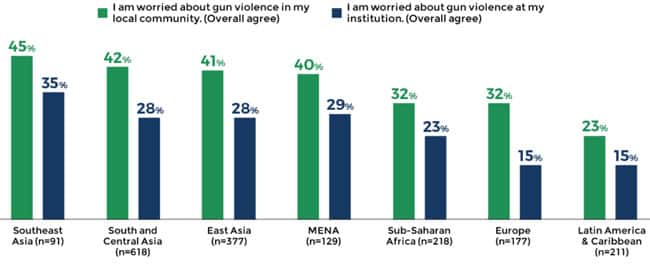Survey measures student concern about gun violence in the US
Last year, two major studies conducted by the Institute of International Education (IIE) and global education advisors IDP revealed growing concerns among American institutions as well as international students around safety in the US.
And earlier this year, World Education Services (WES) conducted its own study to assess international students’ sense of safety while studying in the US. The survey, which gathered responses from 1,920 international students, found that a quarter of respondents are concerned about gun violence at their institution, and nearly four in ten (37%) are worried about gun violence in their local community.
Safety concerns on the rise
IIE’s 2018 survey was conducted among 540 American colleges and universities. It found that institutions attributed recent declines in international enrolments to several factors, chief among them visa application processes or denials (83%, up from 34% in 2016), the social and political environment in the US (60%, up from just 15% in 2016), and students’ decisions to choose destinations other than the US (59%, up from 19% in 2016). Another notable finding was that 44% of institutions said that “physical safety in the US (e.g., gun violence, civil unrest)” was negatively impacting international enrolments, up from just 12% in 2016.
Also in 2018, IDP surveyed almost 3,000 prospective and current international students and found that for the third consecutive year, the US came last in a group of five major English-speaking destinations (Australia, Canada, New Zealand, the UK, and the US) in terms of student perceptions of safety.

Most feel safe but gun violence a top concern
The WES survey found that a strong majority (88%) of the almost 2,000 international students it surveyed feel safe “from physical harm or acts of violence” at their institution, with virtually the same proportion feeling safe from “verbal harm or harassment” (87%). And more than three-quarters feel physically safe and safe from verbal harassment in their local communities.
These are encouraging results, notes WES. Less encouraging, however, are elevated concerns about gun violence: 25% said they are worried about gun violence at their institutions, and 37% said they are concerned about this in the local community.
Concerns spike among students studying in US cities, with four in every ten students (39%) worried about gun violence in their city, compared to 31% in suburbs and 35% in rural communities where gun ownership is common.
Nearly half (45%) of Southeast Asian students are concerned about gun violence in their local US community, and more than a third of these students (35%) feel nervous about this risk at their institution. Rates of worry about gun violence in the US community in which students are living are also high among those from South and Central Asia (42%), East Asia (41%), and MENA – the Middle East and Africa (40%).

Safety perceptions affect student choice
As WES notes,
“Studies have shown the importance of word of mouth and peer recommendations in influencing student decisions on where to study. They also repeatedly emphasise the importance of safety in determining a prospective international student’s study destination.”
WES also points out that international students may perceive more safety risks than domestic students because they “often possess a number of intersecting characteristics, such as gender and nationality, that make them more vulnerable than domestic students to acts of physical and emotional harm.”
The study outlines several steps that receiving institutions can take to help students to feel safer, including:
- Expanding access to safe and affordable student housing, which would make it more likely that students could pay for accommodation in low-crime areas. This could also include “maintaining and distributing registers of recommended local housing which meet safety and other quality standards.”
- Improving or developing intra-campus as well as campus-to-community transit.
- Providing more information about neighbourhoods around campus, including warnings about areas with higher crime rates if this is applicable.
- Briefing incoming students about their rights and legal options as they pertain to safety and what to do if harmed. The range of topics to be addressed would include “immigration law, criminal law (gender violence and harassment in particular), tenancy laws, employment rights, and Health Insurance Portability and Accountability Act (HIPAA) and privacy laws.”
- Harness the expertise of professionals such as “campus security officers, local law enforcement, legal and health professionals, and advocacy groups” via workshops, pamphlets, social media, and international student groups events and meetings.
The report concludes its recommendations by saying that,
“While institutions can do little to affect the seemingly intractable issue of gun violence in the US, they must take steps to reduce the risk of criminal victimisation that can raise a red flag for prospective international students. To be fully effective, these steps must be designed with the unique challenges and vulnerabilities of international students in mind.”
For additional background please see:
Most Recent
-
ICEF Podcast: Engine of growth: The true value and impact of the international education sector Read More
-
Global higher education enrolments expected to grow through 2035, but new challenges must be addressed Read More
-
Canada: A case study of immigration policy impacts on postsecondary institutions and the wider economy Read More
















